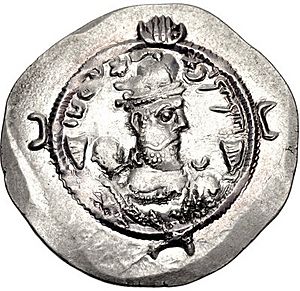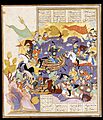Bahram Chobin facts for kids
Quick facts for kids Bahram Chobin𐭥𐭫𐭧𐭫𐭠𐭭 |
|||||
|---|---|---|---|---|---|

Drachma of Bahram Chobin, minted at Arrajan in 590.
|
|||||
| King of Kings of Iran and non-Iran | |||||
| Reign | 590–591 | ||||
| Predecessor | Khosrow II | ||||
| Successor | Khosrow II (restored) | ||||
| Died | 591 Fergana, Western Turkic Khaganate |
||||
| Issue |
|
||||
|
|||||
| House | House of Mihran | ||||
| Father | Bahram Gushnasp | ||||
| Religion | Zoroastrianism | ||||
Bahram Chobin (also known as Bahram VI) was a very important nobleman and general in the Sasanian Empire. This empire was a powerful Persian kingdom that existed long ago. Bahram Chobin even ruled as king for a short time from 590 to 591 AD.
He was the son of a famous general named Bahram Gushnasp. Bahram Chobin came from a noble family called the House of Mihran. He started his career as a governor and quickly became a top army commander. He was known for his great skills and bravery in battle.
Bahram Chobin became famous after winning a huge victory against the Turkic and Hephthalite invaders in the east. However, the Sasanian king, Hormizd IV, became jealous of Bahram's popularity. This led to a major conflict.
Bahram rebelled against King Hormizd IV. During this time, Hormizd was overthrown and killed by other nobles who supported his son, Khosrow II. But Bahram continued his rebellion, even against the new king, Khosrow II. Bahram took control of the capital city, Ctesiphon, and declared himself king.
Khosrow II fled and got help from the Byzantine Empire. With Byzantine support, Khosrow II fought against Bahram. Bahram's forces were defeated, and he had to escape to the Turkic lands. Sadly, he was assassinated there soon after, likely because Khosrow II wanted him gone for good.
Even after his death and the later Arab conquest of Iran, Bahram Chobin remained a hero in Persian literature. Many Iranian people remembered him as a symbol of national pride.
Contents
Who Was Bahram Chobin?
Bahram Chobin's full name was Warahrān, which means "victory" in Old Iranian. It's the name of a god of victory. His nickname, Chobin, meant "Wooden Shaft" or "Javelin-like." People called him this because he was tall and thin. The famous Persian poet Ferdowsi described him as a tall, dark-skinned warrior with curly black hair.
Bahram's Family and Background
Bahram was a member of the House of Mihran, one of the seven most important families in ancient Iran. This family came from a region called Parthia. Their main base was in Ray, a city south of modern-day Tehran.
His father, Bahram Gushnasp, was also a military officer. He fought against the Byzantines and in Yemen. Bahram Chobin's grandfather, Gurgin Milad, was a general in Sasanian Armenia. Bahram Chobin had three siblings: a sister named Gordiya and two brothers, Gorduya and Mardansina.
Bahram's Rise to Power
Bahram Chobin started his career as a governor. In 572, he led cavalry forces and helped capture the important Byzantine stronghold of Dara. Because of this success, he was promoted to army chief of the northwestern part of the Sasanian Empire. He then fought in a long war against the Byzantines in Mesopotamia.
Defeating the Turkic Invasion
In 588, a large army of Turks and Hephthalites invaded the eastern Sasanian lands. They attacked and took over several cities, including Balkh. Bahram was chosen to lead the Sasanian army against them. He was given control of the region of Greater Khorasan.
Bahram's army was small, with only 12,000 skilled horsemen. But they were very effective. In April 588, they ambushed the Turkic and Hephthalite army. They won again in 589, taking back Balkh. Bahram even captured the Turkic king's treasury and golden throne.
He then crossed the Oxus river and won a major victory, personally killing the Turkic king, Bagha Qaghan, with an arrow. Bahram's forces went as far as Baykand, near Bukhara. He also captured the dead king's son, Birmudha, and sent him to the Sasanian capital, Ctesiphon.
Conflict with King Hormizd IV
After his great victories, Bahram was sent to fight nomads in the Caucasus and then the Byzantines in Georgia, where he also won. However, he later suffered a small defeat against a Byzantine army. King Hormizd IV, who was already jealous of Bahram's fame, used this defeat as an excuse to remove him from his position.
Some sources say that Hormizd's minister, Azen Gushnasp, was jealous and accused Bahram of keeping some of the war treasures for himself. Other stories suggest that the Turkic prince Birmudha or other courtiers made Hormizd suspicious. Regardless, Hormizd could not stand Bahram's growing popularity. He disgraced Bahram and sent him a chain and a spindle. This was meant to insult Bahram, implying he was a lowly slave or a woman.
Bahram, who was still in the east, was furious. He decided to rebel against Hormizd.
Bahram's Rebellion
Bahram's rebellion was a huge event. It was the first time in Sasanian history that a powerful Parthian noble challenged the Sasanian royal family. Many soldiers and nobles joined Bahram because of his high status and military skill. He appointed a new governor for Khorasan and then marched towards Ctesiphon.
King Hormizd tried to make peace with his brothers-in-law, Vistahm and Vinduyih, who also disliked Hormizd. But a palace coup happened in Ctesiphon. Vistahm and Vinduyih blinded Hormizd and put his son, Khosrow II, on the throne. Soon after, they killed Hormizd.
However, Bahram continued his march to Ctesiphon, now saying he wanted to avenge Hormizd's death. Khosrow II tried to reason with Bahram, sending him a message that he was the rightful king. But Bahram ignored the warning.
Taking the Capital
A few days later, Bahram reached the Nahrawan Canal near Ctesiphon. He fought Khosrow's forces, who were greatly outnumbered. Khosrow's men eventually lost morale and were defeated. Khosrow, along with his uncles and a few nobles, fled to Byzantine territory. Ctesiphon fell to Bahram.
In the summer of 590, Bahram declared himself king. He claimed that the first Sasanian king had wrongly taken the throne from the Arsacids, and he was now restoring their rule.
Bahram's Short Reign
Bahram tried to gain support by connecting his rule to a Zoroastrian prophecy. This prophecy spoke of chaos and wars at the end of an era, followed by a savior. Many people believed Bahram was this promised savior, Kay Bahram Varjavand. He even minted coins showing himself as an important figure with a special crown.
However, many nobles and priests still supported the young and less experienced Khosrow II.
Khosrow II Gets Byzantine Help
Khosrow II went to Syria and asked the Byzantine emperor Maurice for help to regain his throne. Emperor Maurice agreed. In return, the Byzantines would get back several important cities, and Iran would stop interfering in the affairs of Iberia and Armenia.
In 591, Khosrow, with Byzantine generals and armies, invaded Bahram's territories. Many cities quickly switched their loyalty to Khosrow. Bahram's commanders were defeated and killed. Khosrow II and the Byzantine general Narses moved deeper into Bahram's lands, taking cities like Dara and Mardin. Khosrow was again declared king.
Meanwhile, Khosrow sent one of his supporters, Mahbodh, to capture Ctesiphon, which he successfully did.
The Final Battle
At the same time, an army of 8,000 Iranians and 12,000 Armenians invaded Bahram's territory from the north. Bahram tried to convince the Armenian commander, Mushegh II, to betray Khosrow II. He reminded the Armenians how the Sasanian family had treated them in the past. But Mushegh refused Bahram's offer.
Bahram was finally defeated at the Battle of Blarathon. This forced him to flee eastward with only 4,000 men.
Escape and Death
Bahram marched towards Nishapur, where he defeated armies that were chasing him. He eventually reached Fergana in the Turkic lands. The Turkic king, who was likely Birmudha (the prince Bahram had captured earlier), welcomed him with honor.
Bahram joined the Turkic king's service and became a commander in his army. He even saved the king from a plot against him. Bahram became very popular among the Turks.
However, Khosrow II still felt unsafe as long as Bahram was alive. He managed to have Bahram assassinated. Reports say this was done by bribing members of the Turkic royal family. After Bahram's death, his remaining supporters returned to northern Iran and joined another rebellion against Khosrow II.
What Happened to Bahram's Family?
After Bahram's death, his sister Gordiya traveled to Khorasan and married Vistahm, who was also rebelling against Khosrow II.
Bahram had three sons: Shapur, Mihran, and Noshrad.
- Shapur continued to oppose the Sasanians and joined Vistahm's rebellion. He was later executed.
- Mihran became a general in the Sasanian army and fought against the Arabs in 633. His son, Siyavakhsh, later ruled Ray and took revenge on the family who had caused Bahram's downfall.
- Noshrad was the ancestor of the Samanids, a dynasty that ruled eastern Iranian lands much later. They often highlighted their connection to Bahram Chobin.
Bahram's Lasting Legacy
Bahram Chobin's life story was written down in a book called Bahrām Chōbīn Nāma. This story, mixed with accounts that favored Khosrow II, later appeared in the works of famous Persian writers like Ferdowsi in his epic poem, the Shahnameh ("The Book of Kings"). Many fables and heroic tales are linked to Bahram VI.
Even centuries after his death, Bahram Chobin remained a popular figure among Iranian nationalists. His story showed a brave leader who fought against injustice and tried to restore a past empire. The Samanid dynasty, who were descendants of Bahram Chobin, became one of the first independent Iranian dynasties after the fall of the Sasanian Empire.
Family tree
| Bahram Gushnasp | |||||||||||||||||||||||||||||||||||||||||||||||||||||||||||||||||
| Mardansina | Unknown | Bahram Chobin | Gorduya | Gordiya | |||||||||||||||||||||||||||||||||||||||||||||||||||||||||||||
| Noshrad | Mihran Bahram-i Chobin | Shapur | |||||||||||||||||||||||||||||||||||||||||||||||||||||||||||||||
| Siyavakhsh | |||||||||||||||||||||||||||||||||||||||||||||||||||||||||||||||||
| Toghmath | |||||||||||||||||||||||||||||||||||||||||||||||||||||||||||||||||
| Jotman | |||||||||||||||||||||||||||||||||||||||||||||||||||||||||||||||||
| Saman Khuda | |||||||||||||||||||||||||||||||||||||||||||||||||||||||||||||||||
Images for kids
-
Drachma of the Sasanian king (shah) Hormizd IV (579–590).
-
Gold dinar of Bahram Chobin, Susa mint.
-
Illustration of the forces of Bahram Chobin and Khosrow II fighting.
See also
 In Spanish: Bahram VI para niños
In Spanish: Bahram VI para niños







